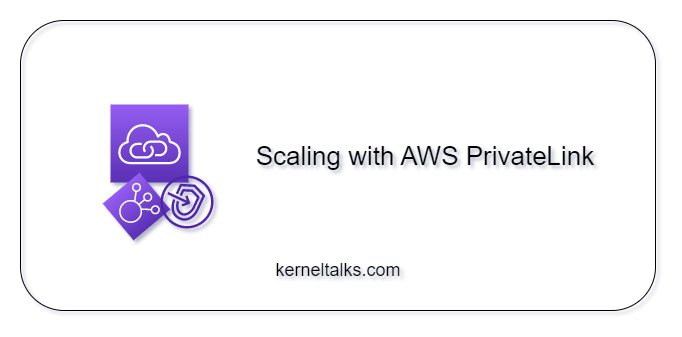In this article, we’ll discuss the scalability aspects of AWS PrivateLink. We’ll examine how the expansion of the service consumer VPC count impacts AWS PrivateLink implementation and its management. Additionally, we will delve into key considerations for designing a scalable solution using AWS PrivateLink.
AWS PrivateLink Primer
AWS PrivateLink provides a method for making your service accessible to other VPCs through a secure, private network connection over the AWS backbone network. This ensures that your data remains within the AWS network, thereby improving security and lowering data transfer expenses compared to when utilizing the public internet. The basic architecture of AWS PrivateLink is depicted as follows –
To set up the connection, you must establish an Endpoint Service within the service provider VPC, using a network/gateway load balancer. In the service consumer VPC, you should create a VPC endpoint that links to this Endpoint Service. The endpoint policies facilitate access control by specifying which principles are permitted to connect to the Endpoint Service. Please refer to this AWS documentation for more details.
Scalability aspect
Now, let’s discuss the scalability aspect concerning AWS PrivateLink. When we talk about scalability, we’re referring to the expansion of the number of VPCs acting as service consumers. In scenarios where you have critical or shared services hosted within the service provider VPC and made accessible through AWS PrivateLink for consumption by services located in different VPCs, it’s clear that the count of consumer VPCs will keep increasing. Therefore, it becomes essential to take scalability considerations into account.
Various VPC endpoints situated in different consumer VPCs can establish connections with a single endpoint service located in the service provider VPC. Hence, you can think of a high-level architecture as below –
Furthermore, it’s important to note that AWS PrivateLink can enable communication to endpoints located in different AWS Regions through the use of Inter-Region VPC Peering.
I recommend reading this AWS blog, which outlines an architecture involving PrivateLink and Transit Gateway. This approach has the potential to significantly decrease the number of VPC endpoints, streamline the deployment of VPC endpoints, and offer cost optimization benefits, especially when implementing solutions at scale.
Scaling considerations
While it’s possible to configure many-to-one connectivity using AWS PrivateLink, there are several important factors to keep in mind when considering this type of scaling:
- Cost and management: As you introduce new consumer VPCs to AWS PrivateLink, you’ll also be adding new VPC endpoints to your infrastructure, which can add to your billing and infrastructure management overhead.
- AWS PrivateLink quotas: Be sure to take into account AWS PrivateLink quotas, as these define the limits for various aspects of your PrivateLink setup.
- Network throughput: VPC endpoints support a maximum throughput of 100Gbps. This is an important consideration for applications that have high network demands when exposed through AWS PrivateLink.
- LB quotas: Be considerate about network load balancer quotas/gateway load balancer quotas.
- IP requirements: AWS PrivateLink consumes a certain number of IP addresses for Load Balancers and endpoints from your VPC’s IP address pool. Ensure that your VPCs can accommodate these IP requirements without causing IP address exhaustion.
Transit Gateway as an alternative?
Let’s look at Transit Gateway if it can be an alternative in a continually expanding VPC environment.
- If unidirectional traffic is your primary requirement, AWS PrivateLink is the choice.
- For a cost-efficient solution, AWS PrivateLink is certainly more economical than Transit Gateway.
- It’s worth noting that Transit Gateway is not suitable when dealing with VPCs that have overlapping CIDRs.
- In a nutshell, Transit Gateway becomes a viable alternative only when you are designing a highly scalable solution involving a significantly huge number of participating VPCs with non-overlapping CIDRs, and your solution prioritizes simplicity and reduced management overhead over cost considerations.
